Laurel (Bay leaf)

Laurel is an evergreen plant whose leaves are used as a spice. Laurel has been known to mankind for many millennia. For ancient people, it had a sacred meaning and was considered an attribute of the gods. In other languages, the name of this plant sounds like this:
- German - Gewürzlorbeer, Loorbeerbaum;
- English - sweet bay, bay laurel;
- French - laurier.

Appearance
Laurel is a shrub or tree, reaching 15 meters in height. The crown of the plant most often has the shape of a pyramid. The leaves are leathery, oblong pointed at the ends. A characteristic feature of the plant: the upper side of the leaf is dark and glossy, and the lower side is light and matte. The inflorescences are small, white-yellow, collected at the base of the leaves in fluffy balls. The fruits are small, blue-black berries with one large seed.


Kinds
The genus Laurel has only three types of plants:
- noble - the most common type, it is he who is most often used in cooking;
- Azorean - the stems of this plant are covered with a short, soft pile.
- Indian - it can be recognized by the smell of cinnamon and by three longitudinal stripes on the leaves.



Where does it grow?
Asia Minor is considered the birthplace of the laurel tree. Now this plant is common in almost all countries of the Mediterranean basin.On the territory of Russia, laurel can be found in the Krasnodar Territory and on the Crimean Peninsula. This plant prefers to settle in a mild, subtropical climate, close to the sea coast.

blank
Harvesting bay leaves usually occurs on an industrial scale. Raw materials are harvested twice a year, from mid-November to mid-February. The leaves are cut along with the branches. At the same time, they act very carefully so that the tree can recover after pruning and after a while give a new crop. Cut branches are collected in heaps and dried in a warm, well-ventilated area. Then the leaves are separated, placed in bags and sent for sale.

Where and how to choose?
Bay leaf is perhaps one of the most popular spices in our country, so you can buy it in almost any grocery store. If you buy a spice in the market, pay attention to the condition of the leaf - there should be no dark spots on its surface. Their presence means that the leaves were collected from a diseased plant. It is better that the packaging is vacuum. Otherwise, the bay leaf should be transferred to a glass jar.
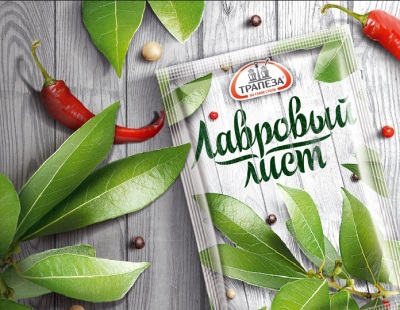
Sheet
Bay leaf is a condiment that is dried laurel leaves. Bay leaf gives dishes a spicy, slightly bitter taste. Fresh bay leaves can also be added to food, however, it should be borne in mind that they have a much richer taste and aroma, so if you make a mistake in the dosage, the taste of the dish will not change for the better.
In addition to cooking, this spice can be used in other areas, including medicine and cosmetology. Bay leaf is characterized by a high percentage of nutrients and therefore has a beneficial effect on the state of the body.
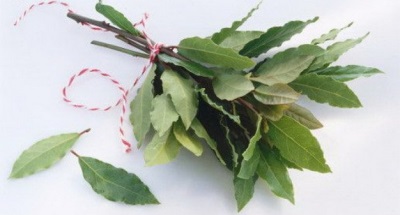
Characteristic
- dark green color;
- sweet, resinous aroma;
- tart-spicy taste.

Nutritional value and calories
| Squirrels | Fats | Carbohydrates | calories |
|---|---|---|---|
| 8 gr. | 8 gr. | 75 gr. | 314 kcal |
You can learn more information about the beneficial properties of bay leaf from the video.
Chemical composition
The beneficial properties of bay leaf are due to the high content of essential oil, which gives a spicy aroma. Laurel contains:
- tannins;
- macro- and microelements - sodium, potassium, calcium, iron, magnesium;
- vitamins - A, C and B6;
- fatty and organic acids - caproic, acetic and valerian.
Due to the high content of phytoncides, bay leaf is a strong natural antibiotic.

Beneficial features
- has an anesthetic effect;
- has a disinfecting effect;
- relieves inflammation;
- normalizes the work of the digestive tract;
- improves appetite;
- has an antiviral effect;
- tones;
- calms the nervous system;
- accelerates wound healing.
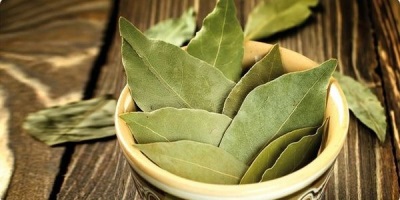
Harm
Like any other spice, bay leaf can not only benefit, but also harm the body. So, the use of a large amount of bay leaf often leads to constipation. In addition, in people with individual intolerance, even from the mere presence of bay leaves in food, signs of a food allergy may appear.
Contraindications
- pregnancy;
- childhood;
- lactation period;
- kidney failure;
- reduced blood clotting;
- amyloid degeneration.
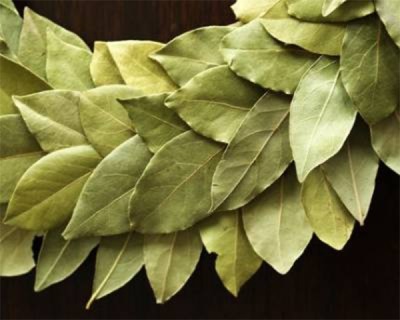
Oil
Laurel essential oil has been used since ancient times to treat a wide variety of ailments. This drug was recommended by the ancient Greek physician Hippocrates - to relieve muscle spasms. Today, laurel oil is used:
- in medicine - for colds, gastrointestinal diseases and skin inflammations;
- in cosmetology - for the care of oily skin and scalp;
- in aromatherapy - to fight viruses and to find peace of mind.
Laurel essential oil has a rich, spicy aroma with a hint of camphor.

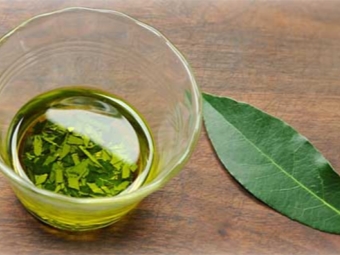
Application
In cooking
- bay leaf is used in canning vegetables, meat and fish;
- add this spice to sweet dishes - jams, canned fruits and compotes;
- bay leaf is used to flavor alcoholic beverages, most often liqueurs;
- spicy sauces and dressings are prepared on the basis of bay leaf;
- bay leaves are added to soups and stews;
- this spice goes well with legumes and cereals;
- bay leaf is used in the production of sausages;
- both whole and chopped bay leaves can be added to dishes.



Pears in muscat wine
Cut one medium-sized beet into slices and place in a saucepan. Pour two glasses of nutmeg, add 1 tbsp. l. sugar, 2 tsp. lemon juice, 2 bay leaves and a cinnamon stick. Stirring constantly, wait for the wine to boil.
When the sugar is completely dissolved, put 3 peeled and halved pears into the pan. Cook, stirring, until the pears soften and the liquid reaches the consistency of a thick syrup.
Put the pears on a plate and pour over the syrup, after removing the bay leaf and cinnamon from the pan. Serve the dish after cooling.

Canned stewed meat
300 grams of any meat cut into small pieces. 8 medium potatoes cut into 4 pieces.
Pour vegetable oil into a deep frying pan and heat. Fry the meat over high heat until golden brown.Then lay out the potatoes and pour water so that the contents of the pan are half covered.
Add salt and pepper to taste, put 1-2 bay leaves. Cook over low heat for 35-45 minutes, adding water if necessary.

In medicine
Laurel leaves are valued not only as a spicy food supplement, but also as a source of nutrients that help to cope with a variety of diseases, including:
- ARI and SARS;
- fungal infections;
- respiratory diseases;
- barley;
- stomatitis;
- insect bites;
- appetite disorders;
- chronic diseases of the gastrointestinal tract;
- food poisoning;
- hypertension;
- the initial stage of diabetes;
- inflammation of the joints;
- painful menstruation;
- psoriasis.
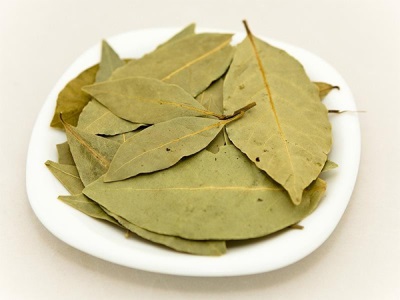
Folk recipes
- With lesions of the oral mucosa, should be chewed 2-3 per day on a bay leaf (preferably fresh), until the inflamed areas heal.
- For insect bites, you should prepare a slurry of fresh bay leaves (you can just chew them) and apply to the affected area, securing with a bandage.
Infusion
- To relieve spasmodic pain, chop 5 grams of bay leaves, pour into a thermos and pour 300 ml of boiling water into it. Infuse for 3 hours, then drain into a clean container through a sieve. You need to drink the infusion during the day, several sips. The course usually lasts no more than 2 days.
- For the treatment of psoriasis put a few large bay leaves in a thermos, pour 2 cups of boiling water and close tightly. After 2.5 hours, pour the infusion into another container. Drink half a glass of infusion half an hour before meals, 3 times a day - until the symptoms disappear.
Decoction
A decoction of laurel leaves is a healing remedy that will help to cope with a variety of diseases, which we will discuss in more detail below.
Traditionally, a bay leaf decoction is prepared as follows:
- 12-13 leaves are placed in a saucepan, pour 1.5 cups of cold water.
- Bring the water to a boil and boil the bay leaf for 4-6 minutes. Next, the broth is poured into a thermos.
- After a few hours, the infused broth is passed through a sieve and poured into a clean container.
Dosage and duration of administration depends on the type and severity of the disease.

To relieve joint pain, you should prepare the following decoction of bay leaves:
- Put 5 grams of spice in a small saucepan and pour 300 ml of cold water.
- Cover with a lid and wait until it boils. Boil the decoction for 4-6 minutes.
- Remove the pan from the heat, wrap in a towel and leave for 4 hours. Filter the infused broth.
Drink the drug should be all day, at regular intervals. The course of treatment lasts 3 days, during which it is necessary to exclude meat products and alcoholic beverages from the diet. Repeat the next course after 7 days, then after a week, after 3 months and after a year.


In cosmetology
- tonic based on bay leaf helps to get rid of acne for a long time;
- alcohol infusion of laurel leaves effectively fights problems associated with excessive oily skin;
- a mask of bay leaf and olive oil moisturizes and nourishes dry skin;
- ointment based on bay leaf and a mixture of oils is an effective remedy for relieving skin inflammation;
- decoction of bay leaf strengthens hair;
- laurel essential oil cleanses the scalp from dandruff.

At home
The spicy smell of bay leaves repels moths and cockroaches, however, fresh rather than dried leaves do this task much more effectively.
cultivation
At home, you can grow a fairly large - up to 2 meters - laurel bush, but you will have to make some effort.
- For growing laurel, only a room with plenty of sunlight is suitable. In summer, it is advisable to take the pot with the plant out into the fresh air. The most suitable temperature for laurel in the summer is from 20 to 26 degrees. In the winter months, the laurel needs coolness. Make sure that the temperature in the room where the laurel stands in winter does not rise above 15 degrees and does not fall below 5.
- Laurel tree needs abundant watering. In summer, the plant can be watered 2 times a day - as the topsoil dries. Every day, the bay tree needs to be sprayed (or install a humidifier in the room).
- Laurel does not need to be transplanted very often. He does well in a pot, so make sure that the new pot is only a couple of centimeters larger than the old one.
- Once a month, the soil in a pot can be fed with fertilizer from a mixture of turf, humus, peat and sand.
- The bay tree can be cut to any shape. The best time for pruning is the end of summer.
- Laurel can be propagated by seeds, cuttings or by dividing the bush.
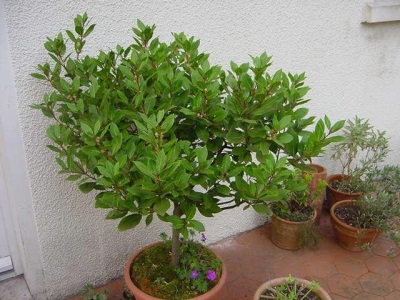
Interesting Facts
- The beautiful Italian names Laura and Lorenzo have their roots in the name of a laurel tree. The old Russian names Lavr and Lavrenty have the same origin.
- Legends and myths of ancient Greece and Ancient Rome are full of references to the laurel tree.Laurel wreaths adorned the heads of prominent artists, whose patron was Apollo. The nymph Daphne, beloved of Apollo, turned into a laurel tree.
- At different times, the laurel was considered a symbol of purity, power and eternal life.
- The laurel wreath can be seen on the coat of arms of Brazil.


















Almost no first dish can do without a bay leaf!